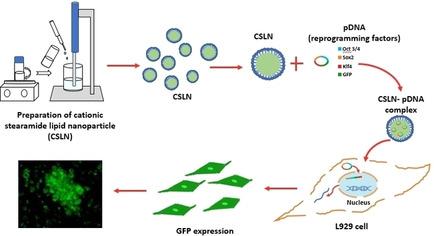当前位置:
X-MOL 学术
›
Chemistryopen
›
论文详情
Our official English website, www.x-mol.net, welcomes your feedback! (Note: you will need to create a separate account there.)
A Cationic Stearamide‐based Solid Lipid Nanoparticle for Delivering Yamanaka Factors: Evaluation of the Transfection Efficiency
ChemistryOpen ( IF 2.3 ) Pub Date : 2020-11-16 , DOI: 10.1002/open.202000244 Funda Alkan 1 , Hanife Sevgi Varlı 1 , Murat Demirbilek 2 , Engin Kaplan 3 , Nelisa Türkoğlu Laçin 1
ChemistryOpen ( IF 2.3 ) Pub Date : 2020-11-16 , DOI: 10.1002/open.202000244 Funda Alkan 1 , Hanife Sevgi Varlı 1 , Murat Demirbilek 2 , Engin Kaplan 3 , Nelisa Türkoğlu Laçin 1
Affiliation

|
Induced pluripotent stem cells (IPSC) are preferred as an alternative source for regenerative medicine, disease modeling, and drug screening due to their unique properties. As seen from the previous studies in the literature, most of the vector systems to transfer reprogramming factors are viral‐based and have some well‐known limitations. This study aims to develop a non‐viral vector system for the transfection of reprogramming factors. Cationic stearamide lipid nanoparticles (CSLN) were prepared via the solvent diffusion method. The obtained CSLNs were used for the delivery of plasmid DNA (pDNA) encoding Oct3/4, Sox2, Klf4, and GFP to fibroblast cell lines. The optimization studies, for zeta potential and particle size of the conjugate, was performed to achieve high cell viability. CSLN63 with 36.5±0.06 mV zeta potential and 173.6±13.91 nm size was used for the transfection of Fibroblast cells. The transfection efficiency was observed by following GFP expression and was found as 70 %±0.11. The expression of the Oct4, Sox2, Klf4 was determined by RT‐qPCR; an increase was observed after the 12th cycle in Klf4 (Ct averages: 13,41), Sox2 (Ct averages; 12,4), Oct4 (Ct average; 13,77). The tendency of colonization was observed. The upregulation efficiency of Oct4 and SSEA‐1 with CSLN and another non‐viral vector designed for the transportation of Yamanaka factors developed in our lab previously were compared with flow cytometer analysis.
中文翻译:

用于传递山中因子的基于阳离子硬脂酰胺的固体脂质纳米颗粒:转染效率的评估
诱导多能干细胞 (IPSC) 由于其独特的特性而成为再生医学、疾病建模和药物筛选的首选替代来源。从之前的文献研究可以看出,大多数转移重编程因子的载体系统都是基于病毒的,并且具有一些众所周知的局限性。本研究旨在开发一种用于转染重编程因子的非病毒载体系统。采用溶剂扩散法制备了阳离子硬脂酰胺脂质纳米粒(CSLN)。获得的 CSLN 用于将编码 Oct3/4、Sox2、Klf4 和 GFP 的质粒 DNA (pDNA) 递送至成纤维细胞系。对缀合物的 zeta 电位和粒径进行优化研究,以实现高细胞活力。使用具有 36.5±0.06 mV zeta 电位和 173.6±13.91 nm 大小的 CSLN63 来转染成纤维细胞。通过跟踪GFP表达观察转染效率,发现转染效率为70%±0.11。RT-qPCR检测Oct4、Sox2、Klf4的表达;第 12 个周期后,观察到 Klf4(Ct 平均值:13.41)、Sox2(Ct 平均值;12.4)、Oct4(Ct 平均值;13.77)有所增加。观察定植趋势。将 Oct4 和 SSEA-1 与 CSLN 和我们实验室之前开发的另一种用于运输山中因子的非病毒载体的上调效率与流式细胞仪分析进行了比较。
更新日期:2020-11-16
中文翻译:

用于传递山中因子的基于阳离子硬脂酰胺的固体脂质纳米颗粒:转染效率的评估
诱导多能干细胞 (IPSC) 由于其独特的特性而成为再生医学、疾病建模和药物筛选的首选替代来源。从之前的文献研究可以看出,大多数转移重编程因子的载体系统都是基于病毒的,并且具有一些众所周知的局限性。本研究旨在开发一种用于转染重编程因子的非病毒载体系统。采用溶剂扩散法制备了阳离子硬脂酰胺脂质纳米粒(CSLN)。获得的 CSLN 用于将编码 Oct3/4、Sox2、Klf4 和 GFP 的质粒 DNA (pDNA) 递送至成纤维细胞系。对缀合物的 zeta 电位和粒径进行优化研究,以实现高细胞活力。使用具有 36.5±0.06 mV zeta 电位和 173.6±13.91 nm 大小的 CSLN63 来转染成纤维细胞。通过跟踪GFP表达观察转染效率,发现转染效率为70%±0.11。RT-qPCR检测Oct4、Sox2、Klf4的表达;第 12 个周期后,观察到 Klf4(Ct 平均值:13.41)、Sox2(Ct 平均值;12.4)、Oct4(Ct 平均值;13.77)有所增加。观察定植趋势。将 Oct4 和 SSEA-1 与 CSLN 和我们实验室之前开发的另一种用于运输山中因子的非病毒载体的上调效率与流式细胞仪分析进行了比较。


























 京公网安备 11010802027423号
京公网安备 11010802027423号